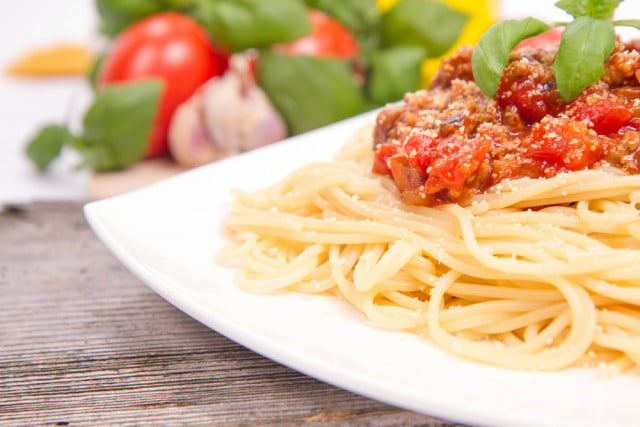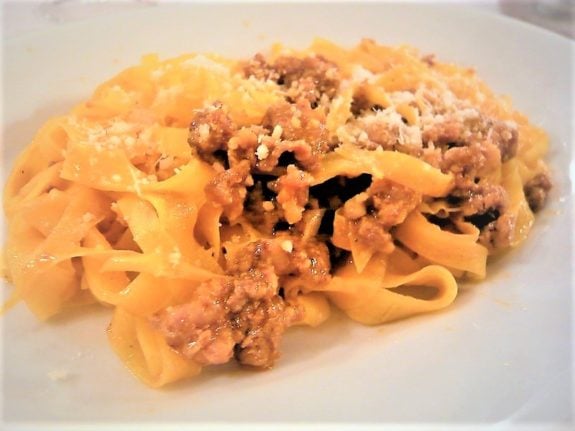Despite or maybe because of its incredible success, the number of recipes – found on amateurs’ blogs and in celebrity chefs’ books – claiming to be the real bolognese sauce is staggering.
Probably just one or two of them are close enough to the traditional recipe. Close, but still not there! To this day, I have not seen yet any recipe that would be able to sustain a claim to be the authentic or traditional one.
READ ALSO: Mayor of Bologna rails against spaghetti bolognese: 'It's fake news'
Bolognese sauce, or ragù – from the French word ragoûter, which means “to revive the appetite” – was originally intended as a festive meal served on its own (without pasta) to soldier and sailors.
Today, bolognese sauce is traditionally served with fresh egg tagliatelle, but it is also used to season other pasta, such as lasagne (with the addition of béchamel sauce), and the queen of peasant cuisine, polenta.
In 1982, the Bologna delegation of the Italian Academy of Cuisine, after years of research consulting old recipe books, hundreds of families, cooks, and sfogline (pasta makers who specialize in pulling paper-thin pasta sheets by hand), published and registered with Bologna's chamber of commerce the official recipe for bolognese sauce. This was meant to preserve the cultural heritage and the historical prestige of the dish.
READ ALSO: Silvana's ten golden rules for cooking pasta like the Italians
And this is the one I give you today. The only and the original.
Of course, there are variations. For instance, I don’t use pancetta, I add more tomatoes, and I prefer to add red wine instead. I also let it cook for far longer than two hours: this because I’m from Naples, and I’m used to ragù cooked for ages.
Variations are a natural occurrence, as we all modify a recipe to adapt it to our tastes and the ingredients we have at hand. However, when people publish a recipe and claim that it’s the real deal, they need to be careful. We Italians have gone a long way to protect our culinary traditions: bolognese sauce is not the only recipe that has been registered with the local chamber of commerce!
READ ALSO: Ten 'Italian' dishes that don't actually exist in Italy

Photo: DepositPhotos
Ingredients
300 g minced beef meat (20 percent fat)
150 g unsmoked pancetta
50 g brown or pink onion
50 g celery
50 g carrot
300 g peeled tomatoes OR tomato passata OR 5 tbsps of double tomato concentrate
200 ml white wine
200 ml milk
Up to 200ml of vegetable stock
1 tbsp tomato concentrate
2 tbsp creme fraiche (optional)
50 gr butter OR 3 tbsps extra virgin olive oil
Salt and pepper to taste
Method
Step 1:
To prepare your bolognese sauce, start by finely chopping the pancetta. Put it in a large, thick-bottomed casserole – ideally cast iron, or the traditional earthenware casserole – and render it over slow heat for about ten minutes.
Step 2:
Meanwhile, finely chop the vegetables. Add the oil OR the butter to the casserole, and stir in the chopped vegetables. Cook on a low heat until they become soft and transparent (about ten minutes). Be careful that the onion doesn’t turn brown.
Step 3:
Add the minced meat, raise the heat to medium, and let it brown, stirring often. Pour in the wine, and keep stirring until it has completely evaporated.
Step 4:
Stir in the tomatoes (either pelati – peeled – OR passata. However, the use of pelati is recommended for ragù). Cover the casserole, and cook for about 2 hours. Add a ladleful of vegetable stock when the bolognese sauce starts to dry up.
Step 5:
About 15-20 minutes before taking your Bolognese sauce off the heat, add the milk and season to taste. When the ragù is ready, take it off the heat and stir in the creme fraiche, which is recommended if using the bolognese sauce with dried pasta. If using fresh pasta, the use of cream is facultative.

Silvana Lanzetta. Photo: Private
Silvana Lanzetta was born into a family of pasta makers from Naples and spent 17 years as a part-time apprentice in her grandmother’s pasta factory. She specializes in making pasta entirely by hand and runs regular classes and workshops in London.
Find out more at her website, Pastartist.com, including this recipe and others.




 Please whitelist us to continue reading.
Please whitelist us to continue reading.
Member comments